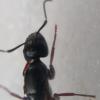Lately, I've been using a method of sampling referred to as the Berlese funnel method, which uses a funnel, a light, mesh, and a collection container to collect soil invertebrates for study. It hinges on the fact that soil arthropods do not tolerate light, and will tunnel to escape it, falling into the container of preservative at the bottom. However, sometimes it doesn't get them all, as they are sometimes able to find damp areas in which to escape to. This is how I managed to find a queen of Stigmatomma pallipes. The soil she was found in was a sample of detritus from the base of a large tulip tree. The soil sample also contained Ponera pennsylvanica, Hypoponera opaciceps, Strumigenys ornata, Proceratium silaceum, and Myrmecina americana. The collection area was a closed canopy oak-hickory forest remnant with tracts of American holly, tulip, winged elm, mockernut hickory, black cherry, flowering dogwood, water and white oak, river birch, red maple, American sweetgum, Ohio buckeye, Eastern redcedar, and loblolly pine. The habitat is situated on a cove of the Saluda River in Prosperity, SC. Unfortunately, this area is set to be cleared within the next few months in order to build a house. Before the area is cleared, I've been doing lots of sampling, particularly in the soil, and I've found the area to be extremely biodiverse, despite it being situated in a developing neighborhood on only an acre of land.
The queen was found while I was cleaning out the funnel, as there was still material in it that had yet to dry out and was stuck to the sides. In this last little bit of soil were tons of Ponera and a single Myrmecina worker, along with this beautiful Stigmatomma pallipes queen. This wasn't the first time I'd collected the species from the area, as I'd collected a single worker once before, but I was definitely surprised to find a single queen. Currently, the queen is being kept in a test tube setup with a soil substrate. I have yet to feed her, but when I do, she will be fed on a diet of primarily soil centipedes and large springtails (there are some around 3 mm I've seen around here). One thing I will do for her is try and see if I can find any workers or other queens to boost her with. I do know of a colony nearby I could collect from, so I'll see if I can find that colony again, as I haven't seen them since last season around September.
I am certainly very excited to be keeping this queen, and I hope she does well. There probably won't be many updates on this queen, as their brood can take nearly a year to develop. However, I'll try and post pictures whenever I can. Stay posted!


Edited by Ferox_Formicae, April 29 2021 - 4:55 AM.


















